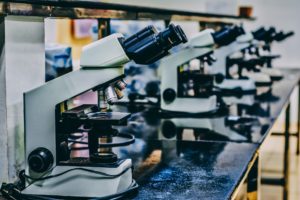2023 in numbers
- 412 hosted projects
- 100 publications
- 24 training programs
- 5 patents since 2011

Technological Innovations
- Adaptive Optics for Quantitative Confocal Microscopy (AOQCM)
- Brillouin microscopy to map elastic forces
- Adhesion forces measurements by RICM-microfluidic coupling (RICM, Reflection Interference Contrast Microscopy)
- FastFLIM imaging integrated on TIRF microscopy
- MERFISH / 3D Spatial transcriptomics
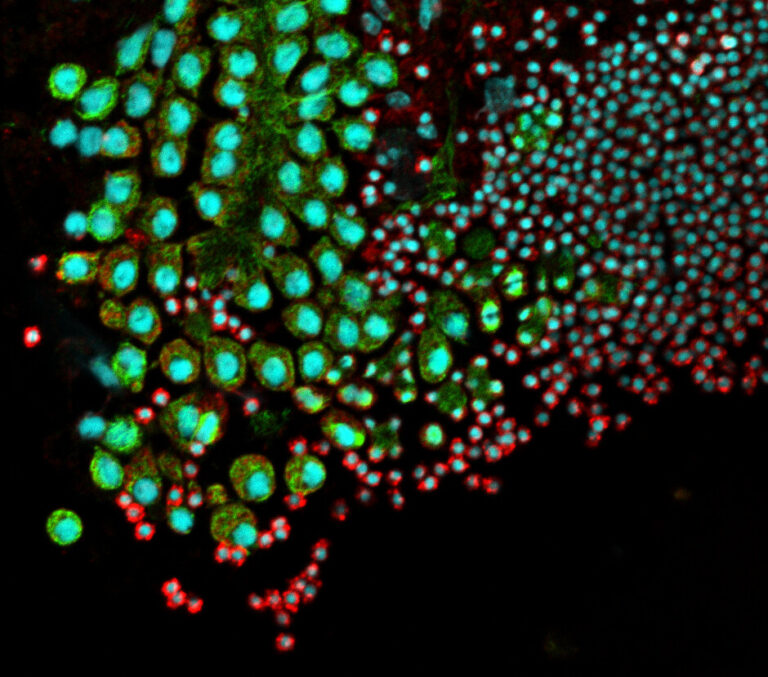
Tech transfer
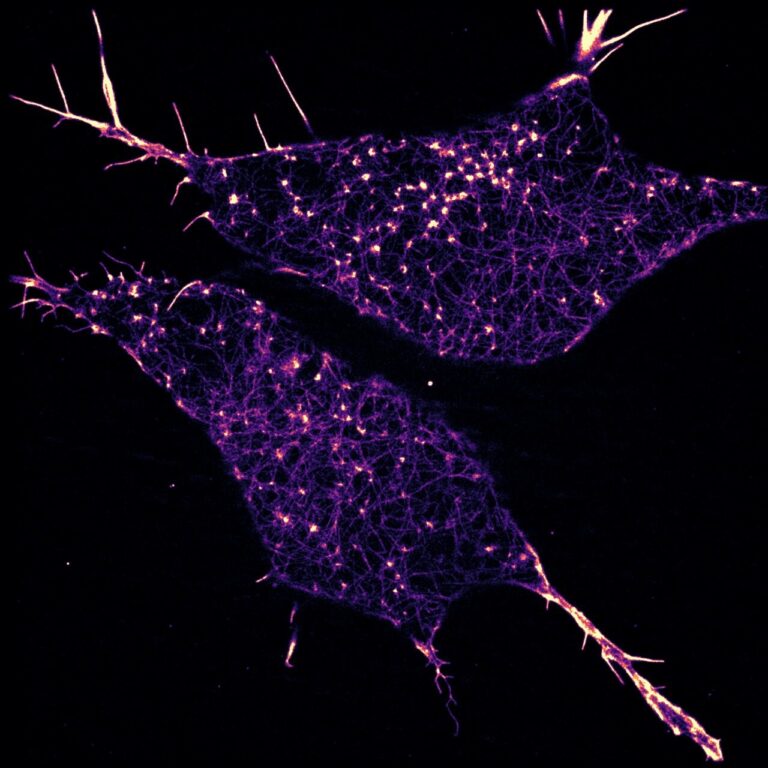
Most innovative systems available for booking
- AFM Nanowizzard IV with hybrid stage [to be delivered Dec 2024]
- Confocal easy3D STED Abberior microscopes with adaptive optics, MATRIX detection and Timebow lifetime imaging
- Nanoscope STEDYCON Abberior
- Adaptive Optics for Quantitative Confocal Microscopy on a Nikon confocal microscope coupled with 2-photons imaging
- Lightsheet microscopes – Blaze (Miltenyi Biotec) & LS7 (Zeiss)
- Confocal Zeiss LSM 710 for molecular dynamics, equipped with Fast-FRAP and Fluorescence correlation spectroscopy (FCS) modules and 2-photons imaging
- Super-resolution microscope Safe360 from Abbelight mounted on an Olympus set-up
Lyon multiscale imaging center (LyMIC)
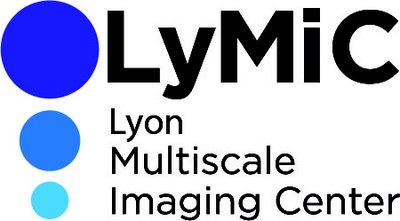
Facility: Lyon multiscale imaging center (LyMIC)
Scientific Director: Pierre-François BREVET
Lyon Multiscale Imaging Center is a microscopy facility opened to academic research and industry. It federates 3 imaging centers in the Lyon area and provides multi-scale imaging tools including light and electron microscopy:
- the PLATIM, located at the Ecole Normale Supérieure de Lyon and at Lyon-Sud Medical University, offers a wide range of light microscopy techniques ranging from fully automated video-microscopy, confocal and two-photon microscopy. The PLATIM accounts also for a platform of atomic force microscopy and microindentation for acquiring high resolution 3D topographies and for measuring micro/nano-mechanical properties.
- the Centre Technologique des Microstructures CTµ, located on the La Doua campus, is mainly an electron microscopy facility that handles multi-disciplinary projects at the interface between biology, chemistry and physics. the CTµ provides access to a wide range of scanning and transmission electron microscopy techniques, and masters cryomethods for sample preparation and observation.
- the East Lyon imaging center (CIQLE) is located in the Rockefeller Medical University. It provides access to wide-field and confocal light microscopy and transmission electron microscopy for the bio-medical research community.
Machines can be operated independently by the users after appropriate training. Users can also benefit partial or full assistance for their projects. LyMIC provides training sessions for groups or individuals.
The team is watching technology progress and implement new techniques to provide state-of-the-art tools.
Services on this Facility
BioBrillouin team – Institut Lumière Matière, UMR CNRS 5306

R&D team: BioBrillouin team – Institut Lumière Matière, UMR CNRS 5306
Team Leader: Thomas DEHOUX
We possess unique Brillouin microscopes for imaging different cells and tissues at various scales:
- VIPA-based interferometer functioning at 660nm for low phototoxicity. Enclosed in an environmental chamber for temperature and CO2 control. Applications include single cells, spheroids and more complex tissues/organisms. Possibility of 3D imaging.
- Standard interferometer for application to mineralized tissues (teeth, bones, shells) and plant epidermises with sub-mm resolution, possibility to reconstruct dispersion curves for analysis of mechanical anisotropy.
We also possess the expertise to analyze, process and model the Brillouin data to obtain information on the mechanical properties (including anisotropy). Home-made microfluidic devices to mount the samples in special conditions (perfusion, mechanical compression, osmotic shocks…) can be engineered with the input of the Biophysics team. Standard microscopy is also available at the ILM (spinning disk, time lapse…)
Publications
- Giulia Guerriero, Alexis Viel, Veronica Feltri, Alice Balboni, Guqi Yan, Sylvain Monnier, Giovanna Lollo and Thomas Dehoux, “Predicting nanocarriers’ efficacy in 3D models with Brillouin microscopy”, Nanoscale 15, 19255 (2023)
- Guqi Yan, Sylvain Monnier, Malèke Mouelhi, and Thomas Dehoux, “Probing molecular crowding in compressed tissues with Brillouin light scattering”, PNAS 119, e2113614119 (2022).
- Laura Bacete, Julia Schulz, Timo Engelsdorf, Zdenka Bartosova, Lauri Vaahtera, Guqi Yan, Joachim Matthias Gerhold, Tereza Tichá, Camilla Øvstebø, Nora Gigli-Bisceglia, Svanhild Johannessen-Starheim, Jérémie Margueritat, Hannes Kollist, Thomas Dehoux, Scott A. M. McAdam, and Thorsten Hamann, “THESEUS1 modulates cell wall stiffness and abscisic acid production in Arabidopsis thaliana”, PNAS 119, e2119258119 (2022).
- T. Lainović, J. Margueritat, Q. Martinet, X. Dagany, L. Blažić, D. Pantelić, M. D. Rabasović, A. J. Krmpot, T. Dehoux, “Micromechanical imaging of dentin with Brillouin microscopy”, Acta Biomater. 105, 214-222 (2020)
- J. Margueritat, A. Virgone-Carlotta, S. Monnier, H. Delanoë-Ayari, H. C. Mertani, A. Berthelot, Q. Martinet, X. Dagany, C. Rivière, J.-P. Rieu, and T. Dehoux, “High-frequency mechanical properties of tumors measured by Brillouin light scattering”, Phys Rev. Lett. 122, 018101 (2019)
Optima team – Liphy

R&D team: Optima team – Liphy
Team Leader: Aurélie DUPONT
The Liphy R&D team has a long experience in collaboration, joint-development and consulting in optic projects between physics and biology labs. Recently, our team developed a robust method to obtain absolute values of FRET from any epifluorescence microscope. The QuanTI-FRET method calibrates the experimental system and the fluorophore pair, allowing for absolute FRET efficiency and stoichiometry measurements in living cells. Current work focuses on skipping the calibration step with specific samples, hence offering a direct calibration on the sample of interest. This project has been partly funded by the SATT Linksium, an intellectual property has been registered on the software part and discussions are ongoing with private partners.
Another part of the team’s expertise is reflection interference contrast microscopy which allows the measurement of distances with nanometric precision in the vicinity of a reference surface, and to assess the surface functionalization in situ without staining (quantification, quality control). The combination with force application techniques such as flow chambers permits probing biomechanics through the simultaneous control of the force (applied) and the distance (measured). This is essential to study adhesions forces of different organisms: from bacteria to immune cells. The dedicated microscope is fully automated with temperature control, and the PI is currently working on the development of a user-friendly interface for biology-oriented projects.
Both developments are unique in France.
MICROcell team – IAB

R&D team: MICROcell team – IAB
Team leader: Olivier DESTAING
Since 2010, we have developped and implemented numerous methods in optogenetics, and even chemogenetics, in order to have access to dynamics and reversible perturbations of key biological functions such as cell adhesion, cell signaling, transcription factors, inflammation, functions of immune cells and even metabolism. Our lab proposes to share this expertise to the FBI users through access for consulting and even direct collaboration. In the Rhonalpin node, our lab is focused on the coupling between optogenetics, biosensors and metabolism imaging through FLIM imaging. Indeed, we have developed a TIRF microscope presenting a module of FastFLIM imaging. Through the use of dark acceptors, this technology allows the users to extend the possibilities in terms of combining optogenetics, biosensors, metabolic imaging through ratiometric probes and classical multicolors TIRF imaging. Moreover, TIRF imaging allows long term live imaging with low levels of photoxicity. This is essential for metabolic imaging and preserving photon budget for FLIM imaging. In the future, this system will be coupled with a module of evanescent field patterning (EFP) in order to have a specific TIRF-mode illumination of only a region of interest (microm scale).
Publications
1- An optogenetic approach to control and monitor inflammasome activation. Julien Nadjar, Sylvain Monnier, Estelle Bastien, Anne-Laure Huber, Christiane Oddou, Léa Bardoulet, Gabriel Ichim, Christophe Vanbelle, Bénédicte Py, Olivier Destaing*, Virginie Petrilli*. Recently accepted in Science Signaling. bioRxiv 2023.07.25.550490; doi: https://doi.org/10.1101/2023.07.25.550490
2-Optogenetic control of YAP cellular localisation and function. Toh PJY, Lai JKH, Hermann A, Destaing O, Sheetz MP, Sudol M, Saunders TE. EMBO Rep. 2022 Sep 5;23(9):e54401.
3-Control of SRC molecular dynamics encodes distinct cytoskeletal responses by specifying its signaling pathway usage. Kerjouan A, Boyault C, Oddou C, Hiriart-Bryant E, Pezet M, Balland M, Faurobert E, Bonnet I, Coute Y, Fourcade B, Albiges-Rizo C, Destaing O. J Cell Sci. 2021 Jan 25;134(2):jcs254599.
4-β1A integrin is a master regulator of invadosome organization and function. Destaing O, Planus E, Bouvard D, Oddou C, Badowski C, Bossy V, Raducanu A, Fourcade B, Albiges-Rizo C, Block MR. Mol Biol Cell. 2010 Dec;21(23):4108-19.
Seed Development team – RDP
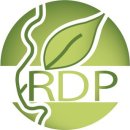
R&D team: Seed Development team – RDP
Team Leader: Gwyneth INGRAM
Over the last ten years, the joint effort of the platform PLATIM and the laboratory of Plant Development and Reproduction (RDP) has developed a strong and recognized expertise in the imaging and quantification of cell mechanical properties in living plant issues. Specific pipelines have been developed to map and quantify:
1. Wall mechanical properties through direct measurements of key parameters such as wall stiffness, adhesion, and resistance to piercing, using AFMs and nano-indenters
2. Cell hydrostatic pressure through stiffness measurements made using AFMs or nano-indenters and the subsequent application of physical models but also through the development of a nano-pressure probe (in progress).
In addition of the originality of these technological approaches in mecanotransduction, the interest of our R&D teams is to develop and support their evolution directly into the environment of an IBiSA core facility. Thus, the R&D Team PLATIM/RDP is one of the rare facilities in France to provide different and integrated mechanical evaluations for both plant and animal multicellular organisms.
Publications:
- Bauer, A., Ali, O., Bied, C., Boeuf, S., Bovio, S., Delattre, A., Ingram, G., Golz, J.F. & Landrein, B. Spatiotemporally distinct responses to mechanical forces shape the developing seed of Arabidopsis. (2024) EMBO J. https://doi.org/10.1038/s44318-024-00138-w
- Creff, A., Ali, O., Bied, C., Bayle, V., Ingram, G. & Landrein, B. Evidence that endosperm turgor pressure both promotes and restricts seed growth and size. (2023) Nature Comm. https://www.nature.com/articles/s41467-022-35542-5
3D electron microscopy team – GIN
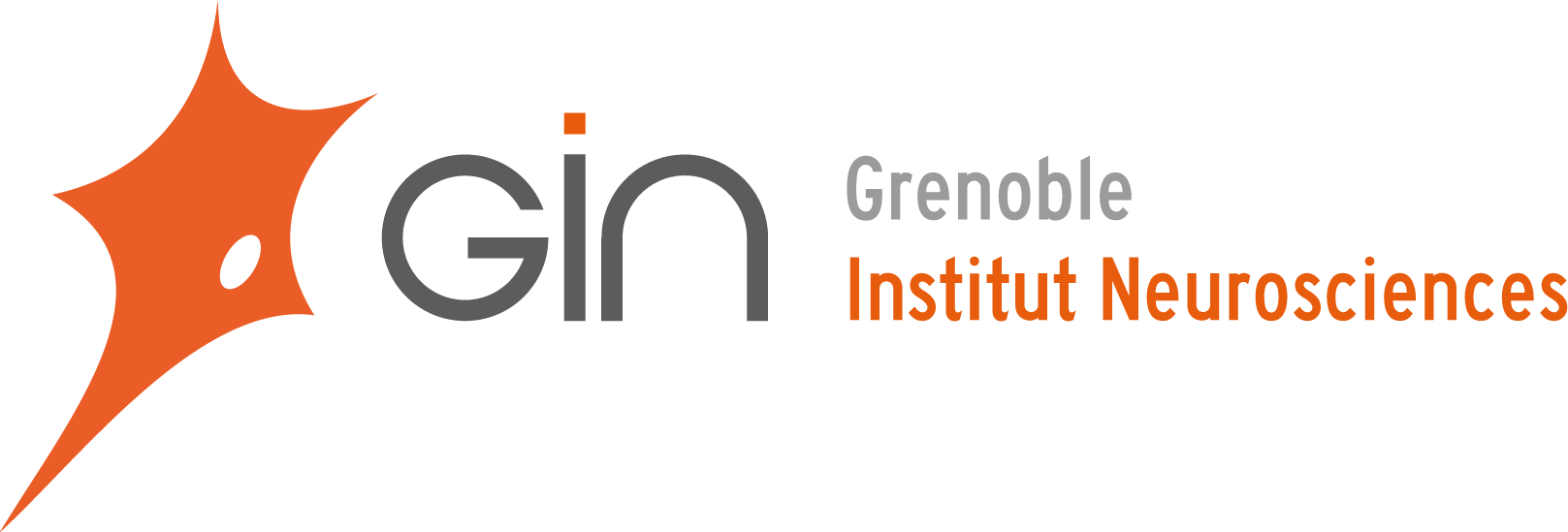
R&D team: 3D electron microscopy team – GIN
Team Leader: Karin PERNET-GALLAY
The development occurring in the platform MEC is tighly associated with joint effort with the “platform of nanocaractérisation” (PFNC) from CEA, leading to have a unique expertise in 3D electron microscopy of large tissue volumes reaching tens of thousands of cubic micrometers at the nanometer scale. This is essential to analyze rare events and true 3D morphological details in neurobiology to study finely cell connectivity, the characterization of membrane structures in chloroplasts from algae and plants, or to study nanoparticles toxicity. Indeed, EM stacks are acquired with much less efforts than by serial sectioning and in a relatively short time (preparation of the sample 3 days, acquisition of the stack 1 day due to high quality stabilization of the samples) new biological questions of interest to the FBI community can be addressed.
Moreover, we have developed a unique pipe-line of analysis of large stacks of 3D EM images. This pipe-line is composed of segmentation steps followed by Ilastik approach for recognition of objects of interests coupled with a serie of home-made plugin specific for quantification. As requested by the network of French electronic microscopists, we are actively collaborating to make available our process to make this pipe-line available for others colleagues and especially the FBI users, as requested by the network of French electronic microscopists. Our work allowed us to develop international collaboration with Andrea Volterra, a world-class leader in the field of FIB-SEM in Neurobiology.
Spatial-Cell-ID EQUIPEX team – ENS
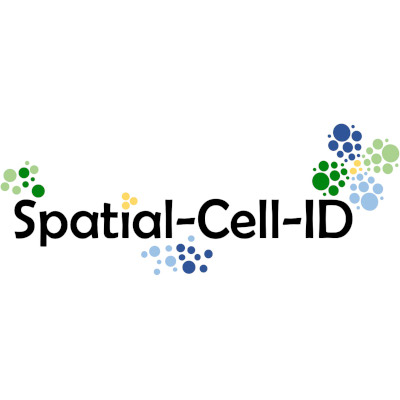
R&D team: Spatial-Cell-ID EQUIPEX team – ENS
Team Leader: Jonathan ENRIQUEZ
Transcriptomic heterogeneity of cells in organisms over time and space necessitates state-of-the-art technologies to access this variability and its dynamics in situ. Hence, the Spatial-Cell-ID facility aims to enhance the spatial resolution of MERFISH for pinpointing transcripts of specific genes (ranging from a few to thousands) in situ, achieving cellular and subcellular precision over time. To achieve this, we employ a microfluidics device enabling multiple rounds of hybridization (smFISH) synchronized with an advanced 3D STED microscope, providing precise spatial localization of RNA spots with a resolution of 50 nm. This technology is tailored for whole-mount samples across diverse organisms, spanning from mammalian cells to invertebrate systems such as Drosophila and C. elegans. Supported by EquipEx+ funding, Spatial-Cell-ID will be nationally accessible through the LyMIC core facility. Our facility complements commercial systems focused on imaging larger samples at lower 2D resolution. Our bespoke solution not only surpasses current state-of-the-art capabilities but also maintains its position at the forefront of technology, with potential future integration of genomic and spatial proteomic techniques.
Publications
Bouchet M., Urdy S., Guan W., Kabir C., Garvis S., Enriquez J. A simple smiFISH pipeline to quantify mRNA at the single-cell level in 3D. (2023). STAR Protocols. Volume 4, Issue 2, 2023, 102316.

